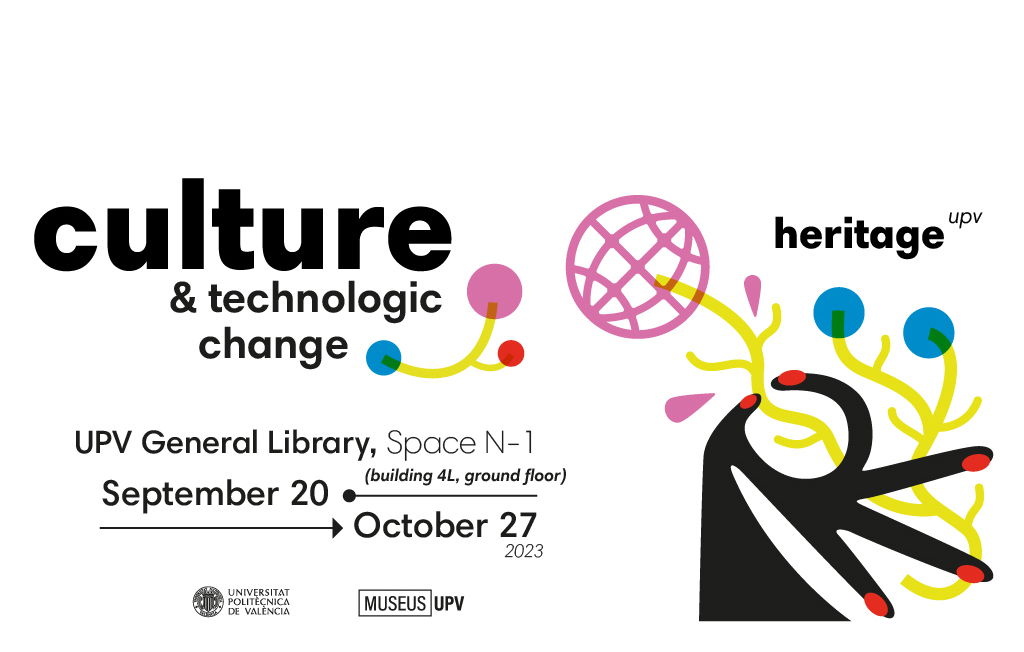
|
|
||||||
Culture Exhibition
14-09-2023
 Exhibitions, Museos
Exhibitions, Museos
EXHIBITION │ Culture & technological change: UPV heritage
September 20 - October 27, 2023
Space N-1, UPV General Library (building 4L, ground floor)
Exhibition_brochure.pdf
The Art Collection and Heritage Department of the UPV is planning this exhibition to enhance the value of its collections and to explore new approaches and readings in order to establish convergent dialogues around art, science and technology.
The great impact of science and technology on culture and society is unquestionable and has been going on since the beginning of humanity, from the invention of the simplest instruments to the most complex and modern technologies. As a result of the practical use of scientific knowledge throughout history, the thread of the exhibition uses the diverse historical-artistic and scientific-technological heritage housed at the Universitat Politècnica de València (UPV). The aim is to identify the most significant technological instruments and reflect on the conflicts generated by scientific progress about the social individual and the phenomenon of globalisation.

Artistic creation, in its quest for beauty and idealised representation, has often been inspired by mathematics to establish balanced and harmonious compositions. In turn, nature itself, where organisational patterns that respond to geometric arrangements or canons reside, has revealed laws and models for artistic, scientific and technological progress.
The rhythm generated by natural elements in the form of spheres and other solids of revolution, waves, polygons, helices and spirals, catenaries or fractals, responds to a motif that is far from random. Their beauty is essentially functional, so that natural arrangements are designed, among other things, to protect, envelop, grasp, emit, move or colonise. In art, these morphologies and concepts have served as sources of inspiration, in the belief that mathematised nature contains perfect proportion; at other times, the artistic work has contravened the logical guideline and, defiantly, has arranged impossible figures and entelechies.
Fibonacci's sequence, the golden ratio or Polyclitus' canon help to understand the works of the most important artists and architects in history. But in the same way, many other mathematical functions and equations explain certain states of biology and botany, the astral movement, the organisation of the universe according to numerical relations, the ordering of quantum systems or even the condition of other realities linked to the economy and social relations.

By following logical reasoning, harnessing scientific knowledge and ordering effective applications of fundamental research, applied science made the development of technology feasible. Advances in all fields triggered globalisation processes that enabled interaction between peoples, markets and cultures.
The emergence of trade routes and naval powers, especially during the 16th and 17th centuries, favoured mercantile exchange, cultural connection and the clash of civilisations. And later, the unstoppable ecumenical interference brought about the intensive construction of infrastructures for globalisation, the emergence of large cities and the means and roads that made their communication possible.
The topographical transformation of the world by technified society has ended up generating spaces of precise coexistence, where natural landscapes are doomed to yield ground in order to understand, dialogue and coexist with human structures which, like a network of conurbations, extend in an integral and connective manner to provide different possible scenarios.

Technological acceleration allowed the development of globalised communities, which reaffirmed their progress and connection thanks to the social implementation of communicative and operational devices. The flow of electrical and electromagnetic signals made possible the invention of the telegraph, radio and telephony, which became essential means of both one-way transmission and mass communication. In turn, computers, with their processing module consisting of arithmetic logic and control units, facilitated the processing of information and later made mass access to internet services and protocols possible.
Capitalist society, with considerable productive development and significant consumption of goods and services, enabled popular access to these devices and other realities such as cinema, television, multimedia content and social networking services. But this prosperity of the fast-paced world, which often clouds traditional and identity structures and forges contradictory processes, ends up modifying human behaviour patterns and generates new challenges with regard to personal interactions and the environment.
The new way of understanding socialisation can end up generating dehumanising complexes and the isolation of the individual from the collective, while technological obsolescence and the abandonment of spaces and buildings due to the end of their useful or productive life originate a significant environmental footprint. For this reason, contemporary development, science, art and technology must redirect their aims towards sustainable progress and adaptability, based on the hope that emerges from cooperation and alliances for a conscious and responsible evolution.

 
|
